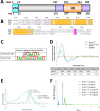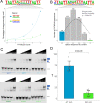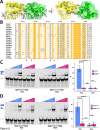This is a preprint.
Cooperative Gsx2-DNA Binding Requires DNA Bending and a Novel Gsx2 Homeodomain Interface
- PMID: 38106145
- PMCID: PMC10723402
- DOI: 10.1101/2023.12.08.570805
Cooperative Gsx2-DNA Binding Requires DNA Bending and a Novel Gsx2 Homeodomain Interface
Update in
-
Cooperative Gsx2-DNA binding requires DNA bending and a novel Gsx2 homeodomain interface.Nucleic Acids Res. 2024 Jul 22;52(13):7987-8002. doi: 10.1093/nar/gkae522. Nucleic Acids Res. 2024. PMID: 38874471 Free PMC article.
Abstract
The conserved Gsx homeodomain (HD) transcription factors specify neural cell fates in animals from flies to mammals. Like many HD proteins, Gsx factors bind A/T-rich DNA sequences prompting the question - how do HD factors that bind similar DNA sequences in vitro regulate specific target genes in vivo? Prior studies revealed that Gsx factors bind DNA both as a monomer on individual A/T-rich sites and as a cooperative homodimer to two sites spaced precisely seven base pairs apart. However, the mechanistic basis for Gsx DNA binding and cooperativity are poorly understood. Here, we used biochemical, biophysical, structural, and modeling approaches to (1) show that Gsx factors are monomers in solution and require DNA for cooperative complex formation; (2) define the affinity and thermodynamic binding parameters of Gsx2/DNA interactions; (3) solve a high-resolution monomer/DNA structure that reveals Gsx2 induces a 20° bend in DNA; (4) identify a Gsx2 protein-protein interface required for cooperative DNA binding; and (5) determine that flexible spacer DNA sequences enhance Gsx2 cooperativity on dimer sites. Altogether, our results provide a mechanistic basis for understanding the protein and DNA structural determinants that underlie cooperative DNA binding by Gsx factors, thereby providing a deeper understanding of HD specificity.
Keywords: Gsx; Homeodomain; cooperative; transcription factor.
Conflict of interest statement
Declaration of Interests R.K. is on the scientific advisory board of Cellestia Biotech AG and has received research funding from Cellestia for projects unrelated to this manuscript. A.B.H. serves on the scientific advisory board for Hoth Therapeutics, Inc., and holds equity in Hoth Therapeutics and Chelexa BioSciences, LLC. The remaining authors declare no competing interests.
Figures






Similar articles
-
Cooperative Gsx2-DNA binding requires DNA bending and a novel Gsx2 homeodomain interface.Nucleic Acids Res. 2024 Jul 22;52(13):7987-8002. doi: 10.1093/nar/gkae522. Nucleic Acids Res. 2024. PMID: 38874471 Free PMC article.
-
Conserved Gsx2/Ind homeodomain monomer versus homodimer DNA binding defines regulatory outcomes in flies and mice.Genes Dev. 2021 Jan 1;35(1-2):157-174. doi: 10.1101/gad.343053.120. Epub 2020 Dec 17. Genes Dev. 2021. PMID: 33334823 Free PMC article.
-
Correction to 'Cooperative Gsx2-DNA binding requires DNA bending and a novel Gsx2 homeodomain interface'.Nucleic Acids Res. 2024 Jul 22;52(13):8037. doi: 10.1093/nar/gkae578. Nucleic Acids Res. 2024. PMID: 38932680 Free PMC article. No abstract available.
-
Homeobox genes Gsx1 and Gsx2 differentially regulate telencephalic progenitor maturation.Proc Natl Acad Sci U S A. 2011 Jan 25;108(4):1675-80. doi: 10.1073/pnas.1008824108. Epub 2011 Jan 4. Proc Natl Acad Sci U S A. 2011. PMID: 21205889 Free PMC article.
-
POU domain factors in neural development.Adv Exp Med Biol. 1998;449:39-53. doi: 10.1007/978-1-4615-4871-3_4. Adv Exp Med Biol. 1998. PMID: 10026784 Review.
References
Publication types
Grants and funding
LinkOut - more resources
Full Text Sources
